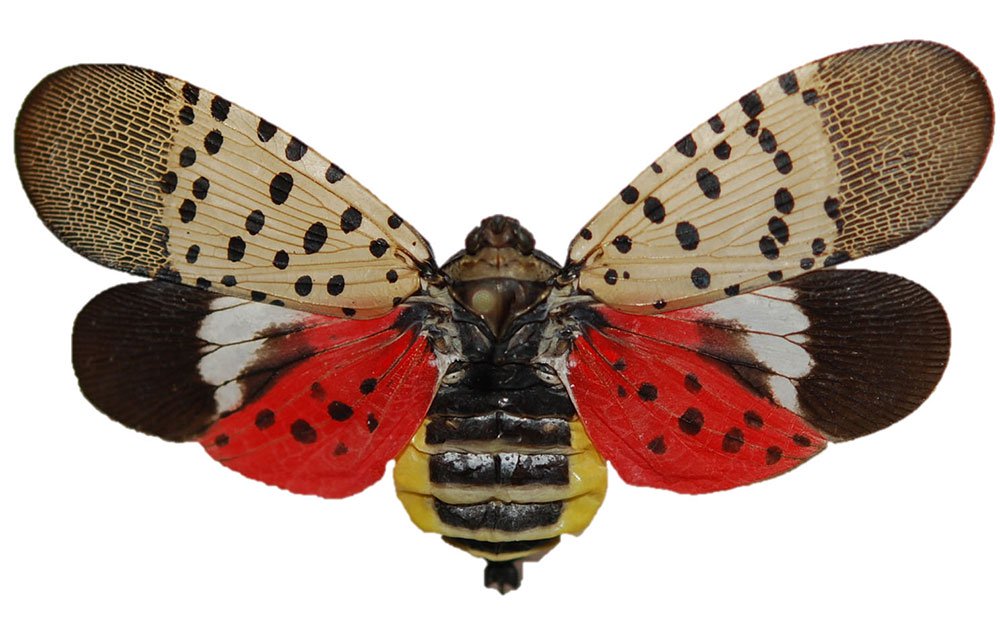
Photo by Pennsylvania Department of Agriculture
Guidelines for detection and reporting
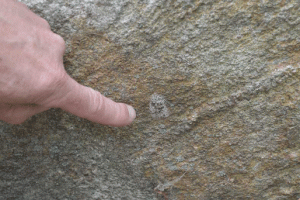 The spotted lanternfly – a destructive, invasive plant hopper attacks many hosts including grapes, apples, stone fruits, walnut, willow, and tree of heaven – has been confirmed in New Castle County. Delaware is the second state to have found the insect, which was first detected in Pennsylvania in 2014.
The spotted lanternfly – a destructive, invasive plant hopper attacks many hosts including grapes, apples, stone fruits, walnut, willow, and tree of heaven – has been confirmed in New Castle County. Delaware is the second state to have found the insect, which was first detected in Pennsylvania in 2014.
This insect is a potential threat to several important commercial crops including grapes, peaches, apples, and timber. State plant health and forestry officials are providing advice to homeowners, businesses, and communities to help identify this pest. Early detection is vital for the protection of Delaware businesses and agriculture.
What is the Spotted Lanternfly?
The spotted lanternfly, Lycorma delicatula, is a plant hopper native to China, India, and Vietnam, that belongs to the order Hemiptera, family Fulgoridae.
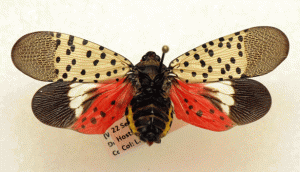 The spotted lanternfly adult is 1” long and 1/2” wide at rest. The forewings are grey with black spots, and the hind wings are red with black spots. The head and legs are black, and the abdomen is yellow with broad black bands. Immature stages are small, round, and black with white spots, and develop red patches as they grow.
The spotted lanternfly adult is 1” long and 1/2” wide at rest. The forewings are grey with black spots, and the hind wings are red with black spots. The head and legs are black, and the abdomen is yellow with broad black bands. Immature stages are small, round, and black with white spots, and develop red patches as they grow.
Officials believe the spotted lanternfly requires feeding on tree of heaven (Ailanthus altissima) to reproduce, however, the insect can be found feeding on other plants and trees as well. Egg masses will be laid on the trunk, branches, and limbs of medium to large trees, often in the upper reaches of the canopy. In springtime, nymphs will hatch and move off the trees and search for new hosts, including several agricultural crops, including grapes, apples, and peaches.
Signs and Symptoms
Susceptible tree species – such as tree of heaven, walnut, and willow – might develop weeping wounds, leaving a greyish or black trail along the trunk. This sap will attract other insects to feed, notably wasps and ants. In late fall, adults will lay egg masses on host trees and nearby smooth surfaces like stone, outdoor furniture, vehicles, and structures. Newly laid egg masses have a grey mud-like covering.
#HitchHikerBug
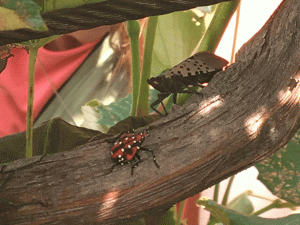 The spotted lanternfly is a very distinct insect at both the nymph and adult phases. The egg masses can be hard to spot making it easy to transport them on vehicles and other outdoor items.
The spotted lanternfly is a very distinct insect at both the nymph and adult phases. The egg masses can be hard to spot making it easy to transport them on vehicles and other outdoor items.
Based on the proximity to Pennsylvania and the ease in which the spotted lanternfly is able to “hitch-hike,” officials believe this could be how the insect was introduced to Delaware. Therefore, it is important for Delawareans and visitors to inspect their vehicles and anything they may be transporting, including trailers, stone, metal, or anything that has spent time outdoors and have an egg mass attached.
How Can You Help?
If you find a spotted lanternfly, there are several ways you can help us stop the #HitchHikerBug:
- Take a picture: With the GPS function turned on your smartphone or a camera with GPS, take a photograph of any life stage (including egg masses). Upload your photograph to Facebook or Instagram, using the hashtag #HitchHikerBug. If you don’t have GPS capabilities and/or access to social media, submit the photograph via email to HitchHikerBug@state.de.us and include your name, contact information, and the address or georeference of where the photo was taken.
- Collect a specimen: Suspected specimens of any life stage can be collected and placed in a vial or plastic zip-lock bag with the name and contact information of the collector, and turned into the Delaware Department of Agriculture CAPS program for verification. This insect is considered a threat to some crops and early detection is vital for the protection of Delaware businesses and agriculture.
- Report a site: If you can’t take a specimen or photograph, send an email to HitchHikerBug@state.de.us, submit using this form or call (302) 698-4586 with a message detailing the location of the sighting and your contact information.
Other Resources:
- Look Before You Move It: Delaware Residential Spotted Lanternfly Checklist
- http://www.hungrypests.com/
What has Delaware been doing to guard against the spotted lanternfly?
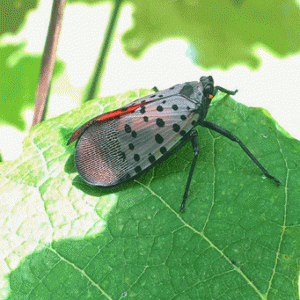 Delaware has been working to monitor for spotted lanternfly infestations since Pennsylvania first detected the insect in 2014. Our Plant Industries inspectors have done visual surveys in areas with Tree of Heaven. With the recent expansion of Pennsylvania’s quarantine to county level and the proximity of these counties to New Castle County, our inspectors ramped up their inspections, detecting one dead spotted lanternfly in the Wilmington area.
Delaware has been working to monitor for spotted lanternfly infestations since Pennsylvania first detected the insect in 2014. Our Plant Industries inspectors have done visual surveys in areas with Tree of Heaven. With the recent expansion of Pennsylvania’s quarantine to county level and the proximity of these counties to New Castle County, our inspectors ramped up their inspections, detecting one dead spotted lanternfly in the Wilmington area.
Officials want to eradicate this pest before it spreads, but as a notorious hitchhiker, vigilance is key. With a hard frost, the adults will die this fall and winter. The egg masses the females lay this fall will survive the winter and hatch out 30-50 nymphs come late April / early May. Locating live or dead adults now will help experts develop a map of distribution to search for egg masses so they can be destroyed. Any egg masses that are found now should be reported to the Department of Agriculture for verification and destruction.
What’s at risk?
If allowed to spread, this pest could seriously impact the grape, orchard, and logging industries. Trees and plants that have been known to be affected are:
- Apples
- Plums
- Hops
- Cherries
- Grapes
- Peaches
- Nectarines
- Apricots
- Almonds
- Pine Trees
- Oak Trees
- Walnut Trees
- Poplar Trees
- Willow Trees
- Maple Trees
- Sycamore Trees
Download and print the Delaware Residential Spotted Lanternfly Fact Sheet.
